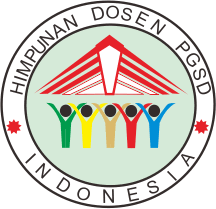Penerapan model project based learning untuk meningkatkan keterampilan identifikasi pokok bahasan bangun ruang pada siswa kelas VI sekolah dasar
Abstract
Keywords
Full Text:
PDFReferences
Ariyana, Y., Pudjiastuti, A., Bestary, R., & Zamromi, Z. (2018). Buku Pegangan Pembelajaran Keterampilan Berpikir Tingkat Tinggi Berbasis Zonasi. Direktorat Jendral Guru Dan Tenaga Kependidikan, 1–87. https://doi.org/10.1016/j.gecco.2019.e00539%0Ahttps://doi.org/10.1016/j.foreco.2018.06.029%0Ahttp://www.cpsg.org/sites/cbsg.org/files/documents/Sunda Pangolin National Conservation Strategy and Action Plan %28LoRes%29.pdf%0Ahttps://doi.org/10.1016/j.forec Bloom, B. S., Engelhart, M. D., Furst, E. J., Hill, W. H., & Krathwohl, D. R. (1956). The Classification of Educational Goals. Taxonomy of Educational Objectives, 62–197. Haskell, R. E. (2001). Transfer of Knowledge. Academic Press. https://www.elsevier.com/books/transfer-of-learning/haskell/978-0-12-330595-4 Izati, S. N., Wahyudi, & Sugiyarti, M. (2018). Project Based Learning Berbasis Literasi untuk Meningkatkan Hasil Belajar Tematik. Jurnal Pendidikan: Teori, Penelitian, Dan Pengembangan, 3(9), 1122—1127-1127. http://journal.um.ac.id/index.php/jptpp/article/view/11508 Kamid. (2013). Metakognisi Siswa dalam Menyelesaikan Soal Matematika (studi kasus pada Siswa SMP berdasarkan gender. Edumatica, 3(1), 64–72. https://online-journal.unja.ac.id/index.php/edumatica/article/view/1411 Murniarti, E. (2017). Penerapan Metode Project Based Learning. Journal of Education, 3(2), 369–380. Nidawati. (2013). BELAJAR DALAM PERSPEKTIF PSIKOLOGI DAN AGAMA. Jurnal Pionir, 1(1), 13–28. Nurohman, S., Nidn, M. P., & Nurohman, S. (2013). Artikel Ilmiah PENGEMBANGAN APLIKASI. November. Pane, A., & Darwis, D. M. (2017). Belajar Dan Pembelajaran. FITRAH:Jurnal Kajian Ilmu-Ilmu Keislaman, 3(2), 333. https://doi.org/10.24952/fitrah.v3i2.945 Redhana, I. W. (2019). Mengembangkan Keterampilan Abad Ke-21 Dalam PEMBELAJARAN KIMIA. Jurnal Inovasi Pendidikan Kimia, 12(1), 2239–2253. Solso, R. L., Maclin, O. H., & Maclin, M. K. (2008). Psikologi Kognitif (W. Hardani (ed.); 8th ed.). Penerbit Erlangga. UU Sisdiknas No Tahun 2003. (2003). Undang UUndang No 20 Tahun 2003 Tentang Sistem Pendidikan Nasional. https://doi.org/10.1111/j.1651-2227.1982.tb08455.x
Refbacks
- There are currently no refbacks.


